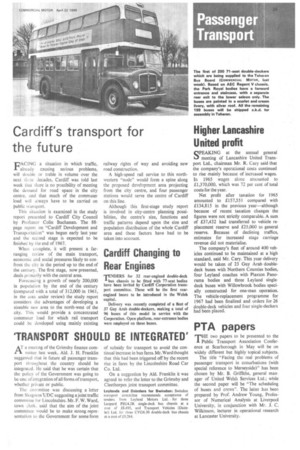Cardiff's transport for the future
Page 37

If you've noticed an error in this article please click here to report it so we can fix it.
FACING a situation in which traffic, already causing serious problems, will double or treble in volume over the next three decades, Cardiff was told last week that there is no possibility of meeting the demand for road space in the city centre, and that much of the commuter load will always have to be carried on Public transport.
This situation is examined in the study report presented to Cardiff City Council by Professor Cohn Buchanan. The 88; page report on "Cardiff Development and Transportation" was begun early last year and the second stage is expected to be finished by the end of 1967.
When complete, it will present a farranging review of the main transport, economic and social pressures likely to confront the city in the period up to the end of the century. The first stage, now presented, deals primarily with the central area.
Forecasting a growth of nearly 200,000 in population by the end of the century (compared with a total of 312,000 in 1961, in the area under review) the study report considers the advantages of developing a sizeable new area to the north-west of the city. This would provide a concentrated commuter load for which rail transport could be developed using mainly existing
railway rights of way and avoiding new road construction.
A high-speed rail service to this northwestern "node" would form a spine along the proposed development area projecting from the city centre, and four passenger stations would serve the centre of Cardiff' on this line.
Although this first-stage study report is involved in city-centre planning possibilities, the centre's size, functions and traffic patterns depend upon the size and population distribution of the whole Cardiff area and these factors have had to be taken into account.
Cardiff Changing to Rear Engines
TENDERS for 32 rear-engined double-deck 'bus chassis to be fitted with 77-seat bodies have been invited by Cardiff Corporation transport committee. These will be the first rearengined buses to be introduced in the Welsh capital.
Delivery was recently completed of a fleet of 37 Guy Arab double-deckers, making a total of 96 buses of this model in service with the Corporation. Open-platform, rear-entrance bodies were employed on these buses.




























































































































